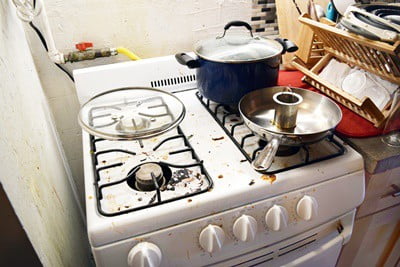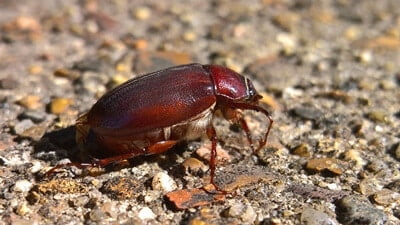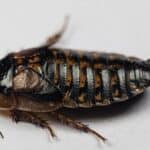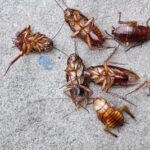It’s hard to believe that your TV, gaming system, laptop, or microwave are at risk of being infested with roaches. In truth, cockroaches can live in your electronics. Once inside, they’ll damage the wiring, leave behind waste and secretions, and corrode the tiny working parts. Many DIY solutions can be harmful to electronic equipment.
You can remove cockroaches from your electronics with dust traps. Baited traps can lure roaches out of your laptop, TV, and other appliances. You can expose inexpensive electronics to cold temperatures to drive out roaches. You could hire an exterminator with tools that can remove or kill roaches without harming your devices.
Some electronics will break when exposed to extreme cold. Never use Raid or other water-based insecticides on your gadgets and devices. Avoid bug-bombing your electronics or putting anything dangerous inside of them.
Why Do Cockroaches Hide in Electronics?
Cockroaches will live where they have access to food, water, shelter, and warmth. Therefore, cockroaches, particularly the smaller species, make homes inside the following electronic devices:
- TVs
- Computers and keyboards
- Microwaves
- Dishwashers
- Washing machines
- Coffee machines
- Toasters
- Refrigerators
- Ceiling fans
- Air conditioning units
- Kitchen mixers
- Gaming consoles
- DVD and Blu-ray players
Cockroaches are thigmotropic. This means they’re attracted to small, solid spaces that encapsulate their bodies. They’re highly responsive to touch, so the tighter the space, the more comfortable they feel. Small spaces also tend to be warm, which is essential for a cockroach’s survival.
According to Live Science, cockroaches flatten their exoskeletons and splay their legs out to the side to fit through small gaps that are approximately 1/4 the size of their standing height. Electronic devices provide several gaps that are small enough for roaches to fit through and feel safe and secure.
These aren’t the only reasons cockroaches are attracted to electronics. They also live in electronics that provide:
- Heat: Electronic devices generate warmth, especially if they’re constantly plugged into a power socket
- Security: Cockroaches will choose electronics that remain in the same place and are rarely dismantled
- Quiet: Electronics tend to produce a quiet hum instead of a loud, threatening noise
- Darkness: Tight spaces don’t let in any light, allowing roaches to remain undetected
- Access to food: Electronics that are kept in kitchens enable roaches to make frequent runs for food and water
- Room to breed: Cockroaches need space to lay their eggs and keep them protected from predators
As you can see, even electronic devices aren’t immune to a cockroach infestation. In many cases, you don’t even know they’re there until their devices are already overrun.
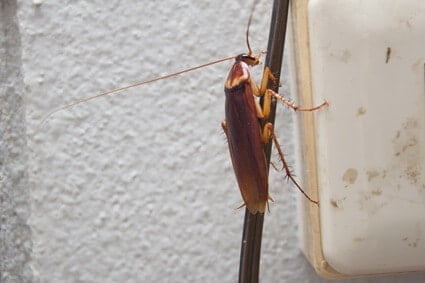
Can Roaches Destroy Electronics?
Once cockroaches make themselves a home inside the electronic circuitry, there’s every chance the pests will ruin your device. They don’t eat the wiring, but they congregate in these areas and cause havoc by:
- Making appliances overheat by blocking air vents
- Causing circuit boards to burn out to smear droppings
- Causing inner workings to jam due to dead cockroaches stacking up
- Blocking or overheating the electronics due to shed exoskeletons
- Resulting in the electronics short-circuiting because they’ve laid eggs against essential parts
Smaller devices, such as gaming consoles and DVD players, are most at risk of breaking entirely because they have smaller parts.
Cockroaches are also more likely to cause significant damage to refrigerators and washing machines, as there will be food traces or starch remnants from laundry detergents for cockroaches to eat. This means small parts get damaged in the process. However, it may be a while before you start to see any damage, which isn’t always fixable.
Can Roaches Cause Electrical Problems?
Aside from jamming up and short-circuiting your electricals, cockroaches can cause electrical fires. Any electronic device is at risk of catching fire, but it’s more likely to happen when roaches get into the power outlets. When they do, they leave behind:
- Droppings
- Fecal smears
- Exoskeletons
- Secretions
- Carcasses
- Shed body parts
The World Health Organization (WHO) describes how roaches produce secretions from their mouths and body glands that can corrode the wiring and receptacles of wiring outlets. Many electrical fires happen due to faulty wiring outlets. It only takes one of the damaged or corroded wires to spark to produce a fire.
However, this is the worst-case scenario. Depending on where they hide, cockroaches are more likely to break your electrical device or trip a wire and prevent the power or lights in your house from working.
Do Roaches Eat Electrical Wires?
Cockroaches rarely eat electrical wires. They don’t provide any nutrients or energy they need to survive. Cockroaches consume organic matter, so you don’t need to worry about cockroaches biting through electrical wires.
However, cockroaches corrode wires with their secretions and waste matter. They can also be attracted to the insulation that wiring provides, which is commonly made from paper and cellulose.
Cockroach saliva turns starch into glucose – a valuable source of energy, sustenance, and nutrients. They also have strong chewing mandibles that enable them to tear through tough objects with ease.
When hungry cockroaches chew and eat wiring insulation, they expose the wires and shorten the appliance’s lifespan.
What Cockroaches Nest In Electronics?
All common house cockroaches are at risk of invading your electronics because they’re all drawn to the same things – food, water, and shelter. However, you’re more likely to find some species than others in your electronics, such as:
American Cockroaches
American cockroaches are one of the most common household cockroaches. They’re drawn to heat and can squeeze into the tiniest gaps. Female s are particularly drawn to the tight spaces that electronics provide because they’re warm and undisturbed, making them the perfect spot to lay their eggs.
German Cockroaches
German cockroaches are a tiny species, fitting into spaces measuring approximately 1/8th of an inch long. They find small gaps in the back of electronic devices and burrow in. However, they will choose others spots first, hiding in electrical appliances if there’s nowhere else suitable for them to live.
Brown-Branded Cockroaches
Brown-banded cockroaches are the smallest cockroaches, so they easily fit inside electronic devices. They’re not too fussy about what they live, so don’t be too surprised if they set up home in the smallest appliances.
How To Get Rid of Roaches in Electronics
When you realize you have cockroaches in your electronics, you need to eradicate them to protect your appliances. However, not all roach removal methods work against electrical devices. If you’re not careful, you could make things worse or start a fire. The best way to get roaches out of electronics is through the following methods:
Manual Removal
If you have an instruction manual to hand, you may be able to manually remove the cockroaches by pulling apart the main components of the device.
However, only attempt this if you’re confident you know how to put the appliance back together. When you find the roaches, use gloves or a paper towel to pick them up, being careful not to touch the cockroach.
Dust Traps
Even though cockroaches make themselves at home in their chosen electronic devices, they still need to come out for food. Dust traps are an effective way to kill emerging roaches, poisoning any pests that walk over them.
Dust traps work best when applied to the area surrounding the infested electronics. You won’t want to use a dust trap inside the device, so place it underneath and around it. This should capture any cockroaches that forage for food and water. You can also place the dust around:
- The cockroach’s food source, and
- Near other hiding places, such as a power outlet
Once a cockroach walks over the dust trap, it’ll become poisoned. When it dies, any remaining roaches will feast on the body, consuming the poison and dying as a result.
Bait Traps
Bait traps are similar to dust traps as they poison any roach that comes into contact with one. They contain an odorless gel that is tempting to roaches, so these traps are more likely to draw them out.
However, unlike bait traps, you can position them much closer to your electronic device without worrying about it damaging, as there’s no risk of dust getting into small nooks and crannies. Place the trap near to the electronic device and wait until the cockroach gets trapped into the poison when it comes out of hiding.
Boric Acid
Not all homeowners like using boric acid inside their homes, but there’s no denying it’s a good pest control method and one of the best for dealing with cockroaches. Sprinkle a thin layer around your electronic device and wait until the cockroaches come into contact with it. It won’t be long until they succumb to the poison.
That being said, Scientific Reports explains how cockroaches are becoming immune to the effects of commercial insecticides, so it may not be as fail-proof as some others out there.
Diatomaceous Earth
Diatomaceous earth (DE) is a natural method of pest control. It’s not a poison, but it’s a type of fine, sand-like powder extracted from diatoms – the microscopic, fossilized shells of algae and various aquatic organisms.
As soon as cockroaches come into contact with it, the powder scratches their exoskeletons and dehydrates them by drawing water, fats, and oils out of them. They’ll die over the course of 2-3 weeks from not being able to absorb any nutrients. Another great thing about diatomaceous earth is that it’s safe for pets and small children to be around.
Cold Temperatures
Cockroaches hate cold temperatures. While this method won’t work with large, heavy, immovable appliances, it’s an effective way to remove cockroaches from smaller, inexpensive devices such as:
- Coffee machines
- Microwaves
- Toasters
- Gaming devices
Be careful with how cold you let your appliances get and follow these steps:
- Power down the device or disconnect it from any power sources.
- Secure it in a large plastic bag, making sure it’s as air and water-tight as possible.
- Leave a small amount of room in the bag for cockroaches to escape into.
- Pop the bag containing the electronic in a freezer or a cold room, such as a garage, shed, or outhouse. The ideal temperature is between 50-35 degrees Fahrenheit
- Leave the device for around 4-5 days.
After this time, the temperatures should have gotten cold enough to drive the cockroaches out of the electronic device, where they become trapped inside the bag. The coldness will also slow the roaches down enough for you to dispose of them. They may even suffocate if the bag’s air-tight enough.
Professional Pest Control
While the methods we’ve mentioned above work to remove cockroaches, they may not be effective enough to remove them altogether, especially if you have several cockroaches in your electronics. If so, it’s time to call in a professional exterminator. While this will be more expensive, a pest control professional will know exactly how to get rid of cockroaches using electronic-friendly methods. They’ll also give you advice on how to prevent the pests from returning.
Can You Spray Raid on Electronics?
Raid is a powerful insecticide that’s found in many kitchen cupboards in the event of troublesome pests, including roaches, flies, wasps, and ants. It’s a liquid poison that comes in the form of a thick, waxy spray that becomes an aerosol once it’s sprayed. Unfortunately, it’s not suitable for electronic devices because it’ll:
- Short circuit your electronic device. Using Raid is similar to spraying your device with water.
- Cause corrosion and long-term deterioration. After a few days, the poison will corrode the pieces, causing the electronic to stop working.
- Lead to a waxy build-up. After regular use, Raid can stop your electronics from working, leaving a thick, waxy coating.
Raid has several uses and benefits, but you must keep it away from your electronics.
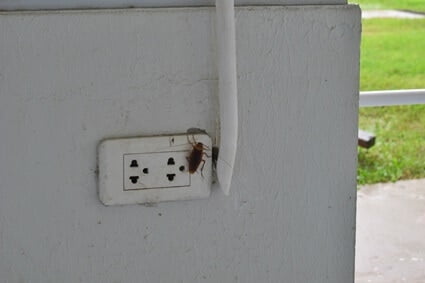
Can You Use a Bug Bomb on Electronics?
Bug bombs are pesticides that release aerosol chemicals. They work by fumigating the environment, killing any cockroaches that come into contact with them. They’re effective against large infestations and are excellent in kitchens where there are multiple nooks and crannies.
That being said, a team of scientists at Envista Forensics discovered that bug bombs contain water traces. Once the bug bomb has been used, water droplets settle on electronics, causing:
- Circuit board corrosion
- Deterioration
- Electronic failure
Bug bombs also contain:
- Ethylene bromide
- Chlorine dioxide
- Methyl bromide
These chemicals can damage electronic devices and are flammable, potentially causing a fire. That’s why you shouldn’t use bug bombs with your electronic devices.
How To Prevent Roaches From Getting Into Electronics
Once you’ve got them out, you’ll need to know how to protect electronics from roaches. The best way is to carry out a regular deep clean, removing any food and water traces that provide them with the sustenance they need to survive. If any remain, cockroaches will keep coming back. Follow these steps to clean your appliances:
- Use a damp cloth to wipe away food spills and grease after every use
- Keep your electronics shut or closed at all times if your device has doors
- Remove any uneaten food, debris, or materials that may attract cockroaches
Cleaning will also enable you to check for any signs of cockroaches, giving you a fighting chance against future infestations. Another way to keep cockroaches away is to use natural repellents where they’re located. Roaches hate the smell of:
- Cedarwood
- Cypress
- Bay leaves
- Catnip
- Rosemary
- Oregano
- Peppermint
- Eucalyptus
- Lemon
Place them in open containers around your containers to keep cockroaches away. When you realize you have cockroaches, be sure to act quickly. The longer the roaches stay in your electronics, the more damage they can cause.
